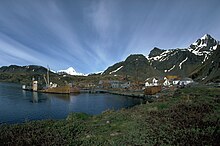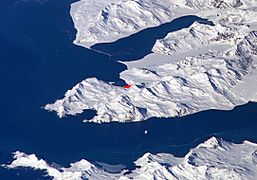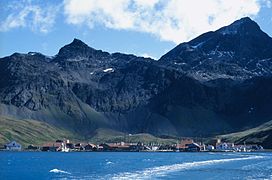Grytviken
Grytviken | |
|---|---|
 | |
 Location of Grytviken and King Edward Point | |
| Coordinates:54°16′53″S36°30′29″W/ 54.28139°S 36.50806°W | |
| Country | |
| British Overseas Territory | |
| Disestablished | 1966 |
| Population (2018) | |
| • Total | 3(summer) |
| Time zone | UTC−2(GST) |
Grytviken(/ˈɡrɪtviːkən/GRIT-vee-kənNorwegian:[ˈɡɾŷːtviːkn̩]) is ahamletonSouth Georgiain the South Atlantic and formerly awhaling stationand the largest settlement on the island. It is located at the head ofKing Edward Covewithin the largerCumberland East Bay,considered the best harbour on the island.[1]The location's name, meaning "pot bay", was coined in 1902 by theSwedish Antarctic Expeditionand documented by the surveyorJohan Gunnar Andersson,after the expedition found old Englishtry potsused to rendersealoil at the site.[2][3][4]Settlement was re-established on 16 November 1904 by Norwegian Antarctic explorerCarl Anton Larsenon the long-used site of former whaling settlements.[5][6]
Grytviken is built on a substantial area of sheltered, flat land and has a good supply of fresh water. Although it was the largest settlement on South Georgia, the island's administration was based at the nearbyBritish Antarctic Surveyresearch station atKing Edward Point.The whaling station closed in December 1966 when dwindling whale stocks made it financially unviable.
Grytviken no longer has permanent residents but occasionally accommodates researchers and British administrative and military personnel. It is also temporarily inhabited during summer months by a few staff who manage theSouth Georgia Museum.The settlement has become a popular attraction for Antarctic cruise lines, with many tourists visiting the resting places of polar explorersSir Ernest ShackletonandFrank WildinGrytviken's graveyard.
History
[edit]Carl Anton Larsen
[edit]The settlement at Grytviken was established on 16 November 1904 by the Norwegian sea captainCarl Anton Larsen,as a whaling station for hisCompañía Argentina de Pesca(Argentine Fishing Company).[7]It was successful, with 195 whales taken in the first season. The whalers used every part of the animals – the blubber, meat, bones and viscera were rendered to extract the oil, and the bones and meat were turned into fertiliser and fodder.Elephant sealswere also hunted for their blubber. Around 300 men worked at the station during its heyday, operating during the southern summer from October to March. A few remained over the winter to maintain the boats and factory. Every few months a transport ship would bring essential supplies to the station and take away the oil and other produce. The following year theArgentine Governmentestablished ameteorological station.
Carl Anton Larsen, the founder of Grytviken, was a naturalised Briton born inSandefjord,Norway.In his application for British citizenship, filed with the magistrate of South Georgia and granted in 1910, Captain Larsen wrote: "I have given up my Norwegian citizen's rights and have resided here since I started whaling in this colony on the 16 November 1904 and have no reason to be of any other citizenship than British, as I have had and intend to have my residence here still for a long time." His family in Grytviken included his wife, three daughters and two sons.
As the manager of Compañía Argentina de Pesca, Larsen organised the construction of Grytviken, a remarkable undertaking accomplished by a team of sixty Norwegians between their arrival on 16 November and commencement of production at the newly built whale-oil factory on 24 December 1904.

Larsen chose the whaling station's site during his 1902 visit while in command of the shipAntarcticof theSwedish Antarctic Expedition(1901–03) led byOtto Nordenskjöld.On that occasion, the name Grytviken ( "The Pot Cove" ) was given by the Swedish archaeologist and geologistJohan Gunnar Anderssonwho surveyed part ofThatcher Peninsulaand found numerous artefacts and features from sealers’ habitation and industry, including a shallop (a type of small boat) and several try-pots used to boil seal oil. One of those try-pots, having the inscription ‘Johnson and Sons, Wapping Dock, London’ is preserved at theSouth Georgia Museumin Grytviken.[8]
Managers and other senior officers of the whaling stations often had their families living together with them. Among them was Fridthjof Jacobsen whose wife Klara Olette Jacobsen gave birth to two of their children in Grytviken; their daughterSolveig Gunbjørg Jacobsenwas the first child ever born and raised south of theAntarctic Convergence,on 8 October 1913. Several more children have been born on South Georgia: recently even aboard visiting private yachts.
The whale population in the seas around the island was substantially reduced over the following sixty years until the station closed in December 1966, by which time the whale stocks were so low that their continued exploitation was unviable. Even now, the shore around Grytviken is littered with whale bones and the rusting remains of whale oil processing plants and abandoned whaling ships.
Ernest Shackleton
[edit]
Grytviken is closely associated with the explorerSir Ernest Shackleton.Shackleton'sImperial Trans-Antarctic Expeditionset out from London on 1 August 1914, to reach theWeddell Seaon 10 January 1915, where the pack ice closed in on their ship,Endurance.The ship was broken by the ice on 27 October 1915. The 28 crew members managed to flee toElephant Islandoff Antarctica, bringing three small boats with them. Shackleton and five other men managed to reach the southern coast of South Georgia inJames Caird.They arrived atCave Cove,and camped atPeggotty Bluff,from where they trekked toStromnesson the northeast coast. From Grytviken, Shackleton organised a rescue operation to bring home the remaining men.
He again returned to Grytviken during theShackleton–Rowett Expeditionand this is where he died, aged just 47, shortly after New Year's Day, prior to the expedition heading south to Antarctica. His widow chose South Georgia as his final resting place so this is where he remained. His grave is located south of Grytviken, alongside those of whalers who had died on the island.
On 27 November 2011, the ashes ofFrank Wild,Shackleton's "right-hand man," were interred on the right side of Shackleton's grave-site. The inscription on the rough-hewn granite block set to mark the spot reads "Frank Wild 1873–1939, Shackleton's right-hand man." Wild's relatives and Shackleton's only granddaughter, Alexandra Shackleton, attended a service conducted by Richard Hines, rector of theFalkland Islands.The writer Angie Butler discovered the ashes in the vault ofBraamfonteinCemetery,Johannesburg,while researching her bookThe Quest for Frank Wild.She said "His ashes will now be where they were always supposed to be. It just took them a long time getting there."[9]
Falklands War
[edit]During theFalklands War,Grytviken was captured by Argentine forces in early April 1982 following a brief battle withRoyal Marines.The Royal Marines,SASandSBSretook the settlement three weeks later without a shot being fired in return.[citation needed]
Supported by the corvetteARAGuerricoon 3 April 1982,ARABahía Paraísolanded a party of Argentine marines whoattacked the platoon of 22 Royal Marines deployed at Grytviken.The two-hour battle resulted in ARAGuerricobeing damaged and an ArgentinePumahelicopter shot down. The Argentine forces sustained three men killed and a similar number of wounded, with one wounded on the British side. The British commanding officer LieutenantKeith Millswas awarded aDistinguished Service Crossfor the defence of South Georgia.[citation needed]
While the British magistrate and other civilians and military present in Grytviken were removed from South Georgia, another 15 Britons remained beyond Argentine reach. The losses suffered at Grytviken prevented Argentina from occupying the rest of the island,[citation needed]withBird Islandbase, and field camps atSchlieper Bay,Lyell GlacierandSt. Andrew's Bayremaining under British control.
On 25 April, theRoyal Navydamaged and captured the Argentine submarineARASanta Feat South Georgia. The Argentine garrison in Grytviken surrendered without returning fire. The following day the detachment inLeith Harbourcommanded by CaptainAlfredo Astizalso surrendered. One prisoner, Felix Artuso, was shot when guards mistakenly believed he was trying to sabotageSanta Fe,and was buried atGrytviken Cemetery.The Argentine personnel were removed from theSouth Sandwich Islandsby HMSEnduranceon 20 June. Due to evidence of an unauthorised visit, the closed stationCorbeta Uruguaywas destroyed in January 1983.[citation needed]
Current situation
[edit]
Along with the surrounding area, the station has been declared an Area of Special Tourist Interest (ASTI).
Grytviken is a popular stop for cruise ships visiting Antarctica, and tourists usually land to visit Shackleton's grave. TheSouth Georgia Museumis housed in the manager's house of the former whaling station, and is open during the summer tourist season.
Thestation's churchis the only building which retains its original purpose; it is still used occasionally for services. There have been several marriages in Grytviken, the first being registered on 24 February 1932, between A.G.N. Jones and Vera Riches.
On 28 January 2007, a service was conducted in remembrance of Anders Hansen (a Norwegian whaler buried at Grytviken Cemetery in 1943) and to celebrate his great-great-grandson Axel Wattø Eide's baptism occurring in Oslo the same day.
Multiple wrecks dot Grytviken, and its environs.[10][11]The shipsPetrel,DiasandAlbatrosswere beached, and left to rust, after decades of service.
Geography
[edit]Climate
[edit]Grytviken and King Edward Point have atundra climate(KöppenET) with long, cold winters and short, cool summers. The highest temperature ever recorded at Grytviken/King Edward Point was 28.8 °C (83.8 °F) on 10 March 1922.[12]
| Climate data for Grytviken/King Edward Point(normals and extremes 2006–2020) | |||||||||||||
|---|---|---|---|---|---|---|---|---|---|---|---|---|---|
| Month | Jan | Feb | Mar | Apr | May | Jun | Jul | Aug | Sep | Oct | Nov | Dec | Year |
| Record high °C (°F) | 23.0 (73.4) |
23.0 (73.4) |
21.6 (70.9) |
21.7 (71.1) |
17.1 (62.8) |
14.1 (57.4) |
14.9 (58.8) |
13.9 (57.0) |
16.0 (60.8) |
20.2 (68.4) |
20.4 (68.7) |
26.4 (79.5) |
26.4 (79.5) |
| Mean daily maximum °C (°F) | 10.0 (50.0) |
10.8 (51.4) |
9.4 (48.9) |
6.1 (43.0) |
3.9 (39.0) |
2.2 (36.0) |
1.7 (35.1) |
2.4 (36.3) |
4.5 (40.1) |
6.9 (44.4) |
8.9 (48.0) |
9.8 (49.6) |
6.4 (43.5) |
| Daily mean °C (°F) | 6.3 (43.3) |
6.9 (44.4) |
5.8 (42.4) |
3.2 (37.8) |
1.0 (33.8) |
−0.4 (31.3) |
−1.2 (29.8) |
−0.6 (30.9) |
1.1 (34.0) |
3.3 (37.9) |
5.0 (41.0) |
6.1 (43.0) |
3.0 (37.5) |
| Mean daily minimum °C (°F) | 2.6 (36.7) |
3.1 (37.6) |
2.2 (36.0) |
0.2 (32.4) |
−2.0 (28.4) |
−4.6 (23.7) |
−4.0 (24.8) |
−3.7 (25.3) |
−2.3 (27.9) |
−0.3 (31.5) |
1.0 (33.8) |
2.3 (36.1) |
−0.5 (31.2) |
| Record low °C (°F) | −2.5 (27.5) |
−3.0 (26.6) |
−4.0 (24.8) |
−7.0 (19.4) |
−10.0 (14.0) |
−11.2 (11.8) |
−15.1 (4.8) |
−13.0 (8.6) |
−11.0 (12.2) |
−9.5 (14.9) |
−5.0 (23.0) |
−4.0 (24.8) |
−15.1 (4.8) |
| Averageprecipitationmm (inches) | 92 (3.6) |
114 (4.5) |
136 (5.4) |
139 (5.5) |
137 (5.4) |
135 (5.3) |
149 (5.9) |
149 (5.9) |
92 (3.6) |
80 (3.1) |
93 (3.7) |
88 (3.5) |
1,394 (54.9) |
| Average precipitation days(≥ 0.1 mm) | 12 | 13 | 14 | 14 | 12 | 15 | 15 | 14 | 11 | 12 | 11 | 11 | 154 |
| Averagerelative humidity(%) | 72 | 69 | 69 | 70 | 74 | 75 | 74 | 73 | 72 | 70 | 69 | 71 | 72 |
| Mean monthlysunshine hours | 152 | 160 | 127 | 66 | 34 | 12 | 22 | 74 | 123 | 171 | 174 | 167 | 1,282 |
| Source 1: Meteomanz[13] | |||||||||||||
| Source 2: Globalbioclimatics/Salvador Rivas-Martínez (precipitation 1901–1950)[14]DMI/Danish Meteorology Institute (sun, humidity, and precipitation days 1931–1960)[15]Météo Climat (extremes)[16] | |||||||||||||
| Climate data for Grytviken/King Edward Point (normals and extremes 1901–1950, sunshine 1931–1960) | |||||||||||||
|---|---|---|---|---|---|---|---|---|---|---|---|---|---|
| Month | Jan | Feb | Mar | Apr | May | Jun | Jul | Aug | Sep | Oct | Nov | Dec | Year |
| Record high °C (°F) | 24.5 (76.1) |
26.5 (79.7) |
28.8 (83.8) |
19.1 (66.4) |
17.5 (63.5) |
14.0 (57.2) |
13.6 (56.5) |
13.2 (55.8) |
17.0 (62.6) |
20.0 (68.0) |
22.5 (72.5) |
21.5 (70.7) |
28.8 (83.8) |
| Mean daily maximum °C (°F) | 8.4 (47.1) |
9.1 (48.4) |
8.4 (47.1) |
5.6 (42.1) |
2.9 (37.2) |
0.9 (33.6) |
1.2 (34.2) |
1.5 (34.7) |
3.5 (38.3) |
5.4 (41.7) |
6.5 (43.7) |
7.5 (45.5) |
5.1 (41.2) |
| Daily mean °C (°F) | 4.6 (40.3) |
5.1 (41.2) |
4.4 (39.9) |
2.3 (36.1) |
0.0 (32.0) |
−1.6 (29.1) |
−1.5 (29.3) |
−1.8 (28.8) |
−0.1 (31.8) |
1.6 (34.9) |
2.7 (36.9) |
3.7 (38.7) |
1.6 (34.9) |
| Mean daily minimum °C (°F) | 1.4 (34.5) |
1.7 (35.1) |
1.0 (33.8) |
−0.8 (30.6) |
−3.1 (26.4) |
−4.6 (23.7) |
−4.7 (23.5) |
−4.9 (23.2) |
−3.3 (26.1) |
−1.8 (28.8) |
−0.5 (31.1) |
0.4 (32.7) |
−1.6 (29.1) |
| Record low °C (°F) | −4.1 (24.6) |
−3.7 (25.3) |
−6.3 (20.7) |
−9.8 (14.4) |
−11.4 (11.5) |
−14.6 (5.7) |
−15.2 (4.6) |
−19.2 (−2.6) |
−18.4 (−1.1) |
−11 (12) |
−6.4 (20.5) |
−5.4 (22.3) |
−19.2 (−2.6) |
| Averageprecipitationmm (inches) | 92 (3.6) |
114 (4.5) |
136 (5.4) |
139 (5.5) |
137 (5.4) |
135 (5.3) |
149 (5.9) |
149 (5.9) |
92 (3.6) |
80 (3.1) |
93 (3.7) |
88 (3.5) |
1,394 (54.9) |
| Average precipitation days(≥ 0.1 mm) | 12 | 13 | 14 | 14 | 12 | 15 | 15 | 14 | 11 | 12 | 11 | 11 | 154 |
| Averagerelative humidity(%) | 72 | 69 | 69 | 70 | 74 | 75 | 74 | 73 | 72 | 70 | 69 | 71 | 72 |
| Mean monthlysunshine hours | 152 | 160 | 127 | 66 | 34 | 12 | 22 | 74 | 123 | 171 | 174 | 167 | 1,282 |
| Source 1: Globalbioclimatics/Salvador Rivas-Martínez[17] | |||||||||||||
| Source 2: DMI/Danish Meteorology Institute (sun, humidity, and precipitation days 1931–1960)[15] | |||||||||||||
Gallery
[edit]-
Grytviken Harbour, showing the whaling station, church and cemetery with Shackleton's grave
-
Whalingand sealing ships at Grytviken
-
Thatcher PeninsulawithKing Edward Coveand Grytviken.
-
TheNorwegian Churchin Grytviken (built in 1913).
-
Grytviken's abandoned whaling station
-
Abandoned buildings at Grytviken.
See also
[edit]- History of South Georgia and the South Sandwich Islands
- King Edward Point
- South Georgia Museum
- Carl Anton Larsen
- Viktor Esbensen
- Solveig Gunbjørg Jacobsen
References
[edit]- ^Holskjær, Lars (2017).Kamper uten tall.Forlagshuset i Vestfold. Page 225.ISBN9788293407294.
- ^Andersson, Johann Gunnar (1944).Antarctic(in Swedish). Stockholm: Saxon & Lindström. p. 192.
- ^Robert Headland (21 May 1992).The Island of South Georgia.CUP Archive. pp. 63–.ISBN978-0-521-42474-5.
- ^Ian B. Hart (2001).Pesca: The History of Compañia Argentina de Pesca Sociedad Anónima of Buenos Aires: an Account of the Pioneer Modern Whaling and Sealing Company in the Antarctic.Aidan Ellis. p. 24.ISBN978-0-85628-299-7.
- ^Headland, Robert (1992).The Island of South Georgia.CUP Archive. Page 130.ISBN9780521424745.
- ^"The Beginnings".Archived fromthe originalon 12 June 2018.Retrieved3 July2018.
- ^R.K. Headland,The Island of South Georgia,Cambridge University Press, 1984.ISBN0-521-25274-1
- ^British Antarctic Survey (1962),Scientific reports,vol. 101–105, British Antarctic Survey, p. 44,OCLC10362390
- ^"Forgotten hero Frank Wild of Antarctic exploration finally laid to rest, beside his 'boss' Sir Ernest Shackleton".Telegraph.London, UK. 27 November 2011. Archived fromthe originalon 28 November 2011.Retrieved21 May2018.
- ^
"Grytviken Whalecatchers".Submerged.co.uk.Retrieved5 April2019.
She was one of the first whale catchers to have a catwalk so that the gunner could run from the bridge to the harpoon gun.
- ^
"Wrecks - South Georgia".Argentine Maritime History.Retrieved5 April2019.
The three small sealers and whale-catchers lie half submerged at the Grytviken jetties.
- ^Remarkable Temperatures in the Argentine and South Georgia.Meteorological Magazine. 57 (6): 138. June 1922.
- ^"SYNOP/BUFR observations. Data by months".Meteomanz.Retrieved21 March2024.
- ^"Temp/Rain 1901–1950"(PDF).Globalbioclimatics. April 2012. Archived fromthe original(PDF)on 1 August 2020.Retrieved10 December2018.
- ^abCappelen, John; Jensen, Jens."South Georgia–Grytviken"(PDF).Climate Data for Selected Stations (1931–1960)(in Danish). Danish Meteorological Institute. p. 242. Archived fromthe original(PDF)on 27 April 2013.Retrieved10 December2018.
- ^"Weather extremes for Grytviken".Météo Climat.Retrieved21 March2024.
- ^"Temp/Rain 1901–1950"(PDF).Globalbioclimatics. April 2012. Archived fromthe original(PDF)on 1 August 2020.Retrieved10 December2018.
External links
[edit]- Grytviken.Copernix satellite image
- Britain's Small Wars: The Argentine Invasion of South Georgia
- Google St View websiteretrieved Jan 2017
- Virtual tour of Grytviken







